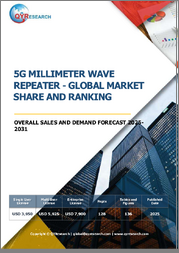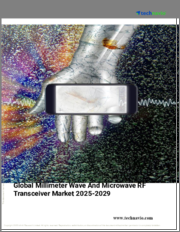
|
시장보고서
상품코드
1701700
밀리미터파 기술 시장 규모, 점유율, 성장 분석 : 컴포넌트별, 제품 유형별, 라이선스 유형별, 용도별, 지역별 - 산업 예측(2025-2032년)Millimeter Wave Technology Market Size, Share, and Growth Analysis, By Components, By Product Type, By License Type, By Application, By Region - Industry Forecast 2025-2032 |
||||||
밀리미터파 기술 시장 규모는 2023년에 31억 달러에 달하며, 2024년 37억 3,000만 달러에서 2032년에는 162억 4,000만 달러로 성장하며, 예측 기간(2025-2032년)의 CAGR은 20.2%로 성장할 전망입니다.
밀리미터파 기술은 첨단 영상 처리, 네트워크, 디스플레이, 보안 솔루션에 대한 수요가 증가함에 따라 의료 및 항공우주 분야에서 빠르게 확산되고 있으며, 14-50m 거리에서 정확한 거주자 감지 및 사람 추적을 가능하게 하는 능력은 빌딩 자동화 및 산업 용도에 대한 매력을 더욱 높이고 있습니다. 자동화 및 산업 용도에서 그 매력을 더욱 높이고 있습니다. 밀리미터파 산업은 재료 과학, 이미징 기술, 산업 공정 제어의 눈부신 발전에 힘입어 성장하고 있습니다. 현재 진행 중인 5G 기술 개발로 인해 밀리미터파는 무선 네트워크에서 데이터 전송 속도를 높이고 대기 시간을 단축하는 데 매우 중요한 요소로 자리매김하고 있습니다. 파로테크와 같은 주요 기업은 혁신적인 솔루션으로 업계를 선도하고 있으며, 첨단 통신 시스템 및 신흥 IoT 용도에 대한 수요 증가에 힘입어 강력한 성장 궤도에 힘입어 많은 투자를 유치하고 있습니다.
목차
서론
- 조사의 목적
- 조사 범위
- 정의
조사 방법
- 정보 조달
- 2차와 1차 데이터 방법
- 시장 규모 예측
- 시장의 전제조건과 제한
개요
- 세계 시장 전망
- 공급과 수요 동향 분석
- 부문별 기회 분석
시장 역학과 전망
- 시장 개요
- 시장 규모
- 시장 역학
- 촉진요인과 기회
- 억제요인과 과제
- Porter의 산업 분석
주요 시장 인사이트
- 주요 성공 요인
- 경쟁의 정도
- 주요 투자 기회
- 시장 에코시스템
- 시장의 매력 지수(2024년)
- PESTEL 분석
- 거시경제 지표
- 밸류체인 분석
- 가격 분석
- 규제 상황
- 사례 연구
- 기술 분석
밀리미터파 기술 시장 규모 : 컴포넌트별
- 시장 개요
- 안테나 및 트랜시버 컴포넌트
- 주파수원 및 관련 컴포넌트
- 통신 및 네트워크 컴포넌트
- 자기 컴포넌트
- RF 및 무선 컴포넌트
- 센서와 제어
- 기타
밀리미터파 기술 시장 규모 : 제품 유형별
- 시장 개요
- 스캐너 시스템
- 액티브 스캐너
- 패시브 스캐너
- 레이더 및 위성 시스템
- 경계 감시 레이더 시스템(PSRS)
- 애플리케이션 고유 레이더 시스템
- 위성통신 시스템
- 통신 장비
- 모바일 백홀 장비
- 스몰셀 장비
- 매크로셀 장비
밀리미터파 기술 시장 규모 : 라이선스 유형별
- 시장 개요
- 라이트 라이선스 주파수
- 언라이선스 주파수
- 완전 라이선스 주파수
밀리미터파 기술 시장 규모 : 주파수 대역별
- 시장 개요
- 24GHz-57GHz
- 58GHz-86GHz
- 87GHz-300GHz
밀리미터파 기술 시장 규모 : 용도별
- 시장 개요
- 통신 및 데이터 통신
- 군과 방위
- 자동차
- 산업
- 소비자
- 의학
- 기타
밀리미터파 기술 시장 규모
- 북미
- 미국
- 캐나다
- 유럽
- 독일
- 스페인
- 프랑스
- 영국
- 이탈리아
- 기타 유럽 지역
- 아시아태평양
- 중국
- 인도
- 일본
- 한국
- 기타 아시아태평양
- 라틴아메리카
- 브라질
- 기타 라틴아메리카 지역
- 중동 및 아프리카
- GCC 국가
- 남아프리카공화국
- 기타 중동 및 아프리카
경쟁 정보
- 상위 5사의 비교
- 주요 기업의 시장 포지셔닝(2024년)
- 주요 시장 기업이 채택한 전략
- 최근 시장 동향
- 기업의 시장 점유율 분석(2024년)
- 주요 기업의 기업 개요
- 기업 상세
- 제품 포트폴리오 분석
- 기업의 부문별 점유율 분석
- 매출의 전년대비 비교(2022-2024년)
주요 기업 개요
- Qualcomm(USA)
- Samsung(South Korea)
- Nokia(Finland)
- Intel(USA)
- Ericsson(Sweden)
- Huawei(China)
- Keysight Technologies(USA)
- TowerJazz(Israel)
- Movandi Corporation(USA)
- Filtronic(UK)
- NEC Corporation(Japan)
- L3Harris Technologies, Inc.(USA)
- Smiths Group PLC(UK)
- Millimeter Wave Products Inc.(USA)
- Axxcss Wireless Solutions(USA)
- Ceragon(Israel)
- Aviat Networks(USA)
- Siae Microelettronica(Italy)
결론과 제안
KSA 25.05.26Millimeter Wave Technology Market size was valued at USD 3.1 billion in 2023 and is poised to grow from USD 3.73 billion in 2024 to USD 16.24 billion by 2032, growing at a CAGR of 20.2% during the forecast period (2025-2032).
Millimeter wave technology is rapidly gaining traction in the healthcare and aerospace sectors, driven by a growing demand for advanced imaging devices, networks, displays, and security solutions. Its ability to enable precise occupancy detection and person tracking within distances of 14 to 50 meters is further enhancing its appeal in building automation and industrial applications. The millimeter wave industry is propelled by significant advancements in material science, imaging technology, and industrial process control. The ongoing rollout of 5G technology has positioned millimeter wave as a pivotal element for achieving faster data transfer and reduced latency in wireless networks. Companies like Pharrowtech are leading the way with innovative solutions, attracting significant investment, reflecting a robust growth trajectory fueled by the increasing need for sophisticated communication systems and emerging IoT applications.
Top-down and bottom-up approaches were used to estimate and validate the size of the Millimeter Wave Technology market and to estimate the size of various other dependent submarkets. The research methodology used to estimate the market size includes the following details: The key players in the market were identified through secondary research, and their market shares in the respective regions were determined through primary and secondary research. This entire procedure includes the study of the annual and financial reports of the top market players and extensive interviews for key insights from industry leaders such as CEOs, VPs, directors, and marketing executives. All percentage shares split, and breakdowns were determined using secondary sources and verified through Primary sources. All possible parameters that affect the markets covered in this research study have been accounted for, viewed in extensive detail, verified through primary research, and analyzed to get the final quantitative and qualitative data.
Millimeter Wave Technology Market Segments Analysis
Global Millimeter Wave Technology Market is segmented by Components, Product Type, License Type, Frequency Band, Application and region. Based on Components, the market is segmented into Antenna and transceiver components, Frequency sources and related components, Communication and networking components, Maging components, RF and radio components, Sensors and controls and Others. Based on Product Type, the market is segmented into Scanner systems, Radar and satellite systems and Telecommunication equipment. Based on License Type, the market is segmented into Light licensed frequency, Unlicensed frequency and Fully licensed frequency. Based on Frequency Band, the market is segmented into 24 GHz to 57 GHz, 58 GHz to 86 GHz and 87 GHz to 300 GHz. Based on Application, the market is segmented into Telecom and datacom, Military and defense, Automotive, Industrial, Consumer, Medical and Others. Based on region, the market is segmented into North America, Europe, Asia Pacific, Latin America and Middle East & Africa.
Driver of the Millimeter Wave Technology Market
The Millimeter Wave Technology market is substantially driven by the demand for advanced 5G infrastructure, primarily found in the US, Japan, South Korea, and China. This contemporary infrastructure necessitates rapid data processing and minimal latency, which is where millimeter wave technology plays a crucial role. Its high-frequency capabilities enable the 5G network to deliver seamless wireless communication over shorter distances while handling vast amounts of data. For instance, forecasts from Huawei anticipate that by 2025, China will encompass one-third of all 5G users. Thus, the increasing need for high transmission frequency rates to optimize network performance significantly propels the growth of the global Millimeter Wave Technology market.
Restraints in the Millimeter Wave Technology Market
A significant factor affecting the growth of the millimeter wave technology market is the rapid deployment of 5G networks, which utilize this technology for enhanced connectivity. However, the short range of millimeter waves poses challenges, as their signals can be blocked by physical barriers like walls and buildings. Moreover, environmental factors such as air pollutants and interference from electrical towers further complicate the effectiveness of this technology. While the rollout of 5G in developed countries is likely to boost demand for millimeter wave technology, the potential negative impact on human health, wildlife, and the ecosystem presents considerable limitations to market expansion.
Market Trends of the Millimeter Wave Technology Market
The millimeter wave technology market is experiencing significant growth, particularly in the expansion of wireless backhaul solutions. With skyrocketing data transmission demands in densely populated urban environments, the technology offers robust, high-capacity connectivity essential for linking base stations to core networks. This trend is fueled by the insatiable need for reliable, high-speed data transmission amidst the proliferation of mobile devices and data-intensive applications. As telecommunications providers seek to enhance their infrastructure to accommodate increasing data traffic, the adoption of millimeter wave technology is poised to surge, solidifying its importance in advancing next-generation wireless communication networks.
Table of Contents
Introduction
- Objectives of the Study
- Scope of the Report
- Definitions
Research Methodology
- Information Procurement
- Secondary & Primary Data Methods
- Market Size Estimation
- Market Assumptions & Limitations
Executive Summary
- Global Market Outlook
- Supply & Demand Trend Analysis
- Segmental Opportunity Analysis
Market Dynamics & Outlook
- Market Overview
- Market Size
- Market Dynamics
- Drivers & Opportunities
- Restraints & Challenges
- Porters Analysis
- Competitive rivalry
- Threat of substitute
- Bargaining power of buyers
- Threat of new entrants
- Bargaining power of suppliers
Key Market Insights
- Key Success Factors
- Degree of Competition
- Top Investment Pockets
- Market Ecosystem
- Market Attractiveness Index, 2024
- PESTEL Analysis
- Macro-Economic Indicators
- Value Chain Analysis
- Pricing Analysis
- Regulatory Landscape
- Case Studies
- Technology Analysis
Global Millimeter Wave Technology Market Size by Components & CAGR (2025-2032)
- Market Overview
- Antenna and transceiver components
- Frequency sources and related components
- Communication and networking components
- Maging components
- RF and radio components
- Sensors and controls
- Others
Global Millimeter Wave Technology Market Size by Product Type & CAGR (2025-2032)
- Market Overview
- Scanner systems
- Active Scanners
- Passive Scanners
- Radar and satellite systems
- Perimeter Surveillance Radar Systems (PSRS)
- Application-specific Radar Systems
- Satellite Communication Systems
- Telecommunication equipment
- Mobile Backhaul Equipment
- Small-cell Equipment
- Macrocell Equipment
Global Millimeter Wave Technology Market Size by License Type & CAGR (2025-2032)
- Market Overview
- Light licensed frequency
- Unlicensed frequency
- Fully licensed frequency
Global Millimeter Wave Technology Market Size by Frequency Band & CAGR (2025-2032)
- Market Overview
- 24 GHz to 57 GHz
- 58 GHz to 86 GHz
- 87 GHz to 300 GHz
Global Millimeter Wave Technology Market Size by Application & CAGR (2025-2032)
- Market Overview
- Telecom and datacom
- Military and defense
- Automotive
- Industrial
- Consumer
- Medical
- Others
Global Millimeter Wave Technology Market Size & CAGR (2025-2032)
- North America (Components, Product Type, License Type, Frequency Band, Application)
- US
- Canada
- Europe (Components, Product Type, License Type, Frequency Band, Application)
- Germany
- Spain
- France
- UK
- Italy
- Rest of Europe
- Asia Pacific (Components, Product Type, License Type, Frequency Band, Application)
- China
- India
- Japan
- South Korea
- Rest of Asia-Pacific
- Latin America (Components, Product Type, License Type, Frequency Band, Application)
- Brazil
- Rest of Latin America
- Middle East & Africa (Components, Product Type, License Type, Frequency Band, Application)
- GCC Countries
- South Africa
- Rest of Middle East & Africa
Competitive Intelligence
- Top 5 Player Comparison
- Market Positioning of Key Players, 2024
- Strategies Adopted by Key Market Players
- Recent Developments in the Market
- Company Market Share Analysis, 2024
- Company Profiles of All Key Players
- Company Details
- Product Portfolio Analysis
- Company's Segmental Share Analysis
- Revenue Y-O-Y Comparison (2022-2024)
Key Company Profiles
- Qualcomm (USA)
- Company Overview
- Business Segment Overview
- Financial Updates
- Key Developments
- Samsung (South Korea)
- Company Overview
- Business Segment Overview
- Financial Updates
- Key Developments
- Nokia (Finland)
- Company Overview
- Business Segment Overview
- Financial Updates
- Key Developments
- Intel (USA)
- Company Overview
- Business Segment Overview
- Financial Updates
- Key Developments
- Ericsson (Sweden)
- Company Overview
- Business Segment Overview
- Financial Updates
- Key Developments
- Huawei (China)
- Company Overview
- Business Segment Overview
- Financial Updates
- Key Developments
- Keysight Technologies (USA)
- Company Overview
- Business Segment Overview
- Financial Updates
- Key Developments
- TowerJazz (Israel)
- Company Overview
- Business Segment Overview
- Financial Updates
- Key Developments
- Movandi Corporation (USA)
- Company Overview
- Business Segment Overview
- Financial Updates
- Key Developments
- Filtronic (UK)
- Company Overview
- Business Segment Overview
- Financial Updates
- Key Developments
- NEC Corporation (Japan)
- Company Overview
- Business Segment Overview
- Financial Updates
- Key Developments
- L3Harris Technologies, Inc. (USA)
- Company Overview
- Business Segment Overview
- Financial Updates
- Key Developments
- Smiths Group PLC (UK)
- Company Overview
- Business Segment Overview
- Financial Updates
- Key Developments
- Millimeter Wave Products Inc. (USA)
- Company Overview
- Business Segment Overview
- Financial Updates
- Key Developments
- Axxcss Wireless Solutions (USA)
- Company Overview
- Business Segment Overview
- Financial Updates
- Key Developments
- Ceragon (Israel)
- Company Overview
- Business Segment Overview
- Financial Updates
- Key Developments
- Aviat Networks (USA)
- Company Overview
- Business Segment Overview
- Financial Updates
- Key Developments
- Siae Microelettronica (Italy)
- Company Overview
- Business Segment Overview
- Financial Updates
- Key Developments



















